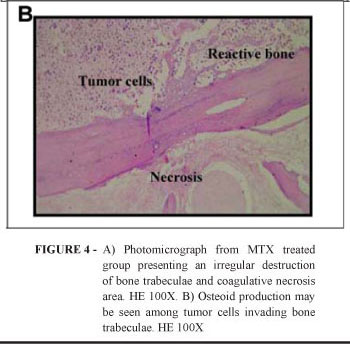PURPOSE: To investigate the effects of bisphosphosnate alendronate (ALD) and metotrexate (MTX) on an experimental model of Walker 256 carcinosarcoma developed in the oral cavity of rats. METHODS Walker 256 carcinosarcoma cell suspension (0,1 mL) containing 10(6) cell/mL was implanted in the alveoli of the first and second molars. The animals were divided and treated with saline, MTX, ALD, and MTX plus ALD. Later, the animals were sacrificed, the tumors were measured and the mandibles were removed for radiographic and histological analysis. RESULTS: In the control group, the radiographic images demonstrated radioluscency with poorly defined borders, and the microscopic examination revealed tumor infiltration into the peripheral and central regions of the bone. Areas of necrosis were commonly seen. In the treated groups with ALD, associated or not with MTX, the radiographic analysis revealed circumscribed tumor-induced osteolysis and various degrees of radiotransparence; while, histologically, preserved bone trabeculae with osteoid formation was observed among malignant cells. CONCLUSION: The bisphosphonate alendronate exherted an osteoprotective effect and induced bone neoformation on the Walker 256 carcinosarcoma inoculated in rat mandibles. The combination of metotrexate with bisphosphonate alendronate is more successful than treatment with the agents alone in controlling the growth of neoplastic cells and in stimulating reactive new bone. Therefore, this may be an alternative treatment to malignant lesions of maxillaries with osteolysis.
Mouth Neoplasms; Animal Experimentation; Carcinoma 256, Walker; Alendronate; Rats












